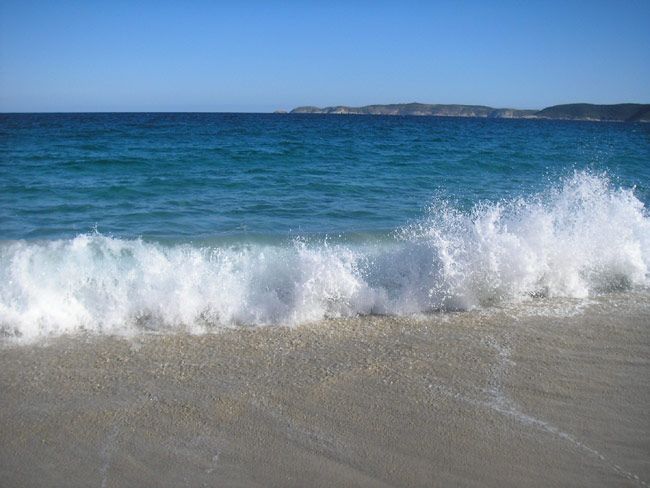The Most Dangerous Things at the Beach

On this Fourth of July weekend, if you dare go in the water, oil may be the least of your worries.
Hundreds of beachgoers have reported feeling ill after visiting Gulf coast beaches. But there and elswhere, plenty of real risks lurk regardless of tar balls.
Though "shark attacks" make big splashes in the news, these toothy fish are not your biggest threat on the beach this summer. In fact, there's more reason for them to fear humans than vice-versa. For instance, in waters off the U.S. eastern seaboard, populations of many shark species have dropped by 50 percent, and some have fallen by as much as 90 percent, due in large part to commercial fishing.
Of course, sharks can be deadly, but so can cars and fireworks. Between 1999 and 2009, the entire United States saw just nine deaths linked to sharks, according to the Florida Museum of Natural History. In 2008 alone, 37,261 people were killed in motor vehicle accidents, according to the National Highway Safety Traffic Administration.
Heat stroke is a common, but serious, problem on beaches across the United States, according to the Centers for Disease Control and Prevention (CDC). Often brought on by dehydration and heat exhaustion, heat stoke occurs when extreme temperatures cause the body's core temperature to exceed 104 degrees Fahrenheit (40 degrees Celsius). When the body is unable to properly cool itself to compensate for the increased heat by sweating, heat stroke may occur.
Sign up for the Live Science daily newsletter now
Get the world’s most fascinating discoveries delivered straight to your inbox.
Common symptoms include nausea, incoherence, fatigue, weakness, vomiting and muscle cramps. While young children and the elderly are the most prone, heat stroke can strike anyone and can be prevented by drinking plenty of fluids, staying out of direct sunlight for prolonged periods of time and reducing outdoor activities during scorching summer days.
"Superbugs," or strains of bacteria that are resistant to traditional antibiotics, do lurk on beaches. The pesky bugs made headlines last year when beachgoers learned they could catch one frightening bacteria, called methicillin-resistant Staphylococcus aureus (MRSA), from an innocent dip in ocean water.
The bacteria can cause serious skin infections and when they bury deep into the body, can lead to life-threatening infections in the bones, lungs and other organs, according to the Mayo Clinic. But don't think staying out of the water will keep you safe – there's also evidence the MRSA is spread in beach sand. To really protect yourself, the CDC advises always taking a shower before and after a swim.
While they may appear to be harmless, squishy blobs, jellyfish can be a real pain, and even quite deadly. The most common jellyfish, called scyphozoans, are not very toxic, and a sting from one usually results in a painful, itchy, and raised red rash that lasts for a few days.
However, one jellyfish does require beachcombers' attention. Box jellyfish, a class that includes 50 described species, have tentacles covered in tiny cnidocysts that each contain a dart and a lethal poison. Once in a victim's blood, this poison can cause a dangerous spike in blood pressure, stop the heart and kill the victim.
To shield yourself from jellyfish, wear protective footwear and keep an eye out for any possibly dangerous marine life. If stung by a jellyfish, the best way to determine how the sting should be treated is to have a health professional identify the species, the CDC advises.
While you bake in your lounge chair, ultraviolet light from the sun zaps through your skin and kills living cells that normally work to help make new skin. Exposure to the sun's UV rays can cause genetic mutations in your cells and lead to cancer. Over 90 percent of all skin cancers are caused by exposure to the sun, according to the Skin Cancer Foundation (SCF).
A sunburn's sting lasts for much longer after the redness has faded. Blistering sunburns during childhood and adolescence increase your risk of developing skin cancer as an adult, as melanoma can develop decades after the initial DNA-damaging sunburn takes place.
When it comes to sun protection, reapplying a sunscreen with an SPF of at least 30 every two hours, and staying in the shade or covering up when in direct sunlight is your best bet, according to the SCF.
That warm, glistening sand may seem welcoming, but it can harbor a potentially dangerous disease-causing bacteria. Harmful strains of E. coli have been found on beaches all over the country, leading to several beach closures, because the presence of E. coli is an indicator of fecal contamination.
While E. coli is one of the main species of bacteria that live in the lower intestines of mammals, including humans – one person excretes billions of them in a day – ingesting pathogenic strains of E. coli can make you very sick. Symptoms of E. coli poisoning include vomiting, bloody diarrhea, severe abdominal pain and a mild fever, according to the CDC.
To stay safe from the beach's buffet of bacteria (in both water and sand), doctors advise against swallowing water while swimming. Washing your hands frequently, especially after using the bathroom and before eating, will also lower your chances of an infection.
More than 100 drownings are due to deadly rip currents each year in the United States, and more than 80 percent of water rescues on surf beaches are due to rip currents, according to the United States Lifesaving Association.
Rip currents, which can happen at any beach that has breaking waves, are usually narrow, fast-moving streams of water that travel away from shore. They happen when waves break strongly in some locations and weakly in others, and can be affected by the presence of sandbars or man-made structures, such as piers near the beach.
If caught in one, NOAA recommends swimmers remain calm and don't try to fight the current. Swim out of the current in a direction following the shoreline, and when out of the current, swim at an angle away from the current and toward shore.
- Dangers in the Deep: 10 Scariest Sea Creatures
- Jaws of Death: 10 Reasons Great White Sharks Are Great
- Top 10 Mysterious Diseases













